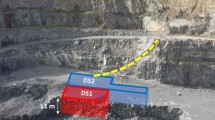Abstract
Assessing the existence, location, and mapping of geologic anomalies, such as fractures and cavities within soil and rock, are common to both engineering and hydrologic project needs. There are numerous measurement techniques available to detect, map, and characterize fractures and cavities. A summary of the common methods available for fracture and cavity detection and mapping are presented along with their spatial sampling capabilities. The remote sensing and geophysical methods are but a small part of this list but provide a wide range of tools to attack the problem. They include some of the most effective methods for locating and mapping fractures and cavities and cover the complete range of spatial sampling, from regional to no more than the surface of a borehole wall. An understanding of all of the tools available and their spatial sampling limitations is a necessary part of planning and carrying out an effective fracture/cavity investigation.
Similar content being viewed by others
References
Benson RC (1978) Assessment of localized subsidence (before the fact) proceedings of the international conference on evaluation and prediction of subsidence. Pensacola Beach, Florida: American Society of Civil Engineers. pp 47–57
Benson RC and La Fountain LJ (1984) Evaluation of subsidence or collapse potential due to subsurface cavities. In: Proceedings of the First Multidisciplinary Conference on Sinkholes. Orlando, Florida. pp 201–215
Benson RC and Pasley D (1984) Ground water monitoring—a practical approach to major utilities. Presented at the Fourth National Symposium and Exposition on Aquifer Restoration and Ground Water Monitoring Columbus, Ohio.
Benson RC and Scaife J (1987) Assessment of flow in fractured rock and karst environments. In: Proceedings from the 2nd Multidisciplinary Conference on Sinkholes and the Environmental Impacts of Karst. Orlando, Florida. pp 237–245
Benson RC and Yuhr L (1987) Assessment and long term monitoring of localized subsidence using ground penetrating radar. In: Proceedings from the 2nd Multidisciplinary Conference on Sinkholes and the Environmental Impacts of Karst. Orlando, Florida. pp 161–169
Benson RC and Yuhr L (1990) Evaluation of fractures and cavities in silts and clay using ground penetrating radar. Presented at the Third International Conference on Ground Penetrating Radar, Lakewood, Colorado
Benson RC, Glaccum RA, and Noel MR (1982) Geophysical techniques for sensing buried wastes and waste migration. For the Environmental Protection Agency. Dublin, Oltio: National Water Well Association. 236 pp
Da Cunha AP (1990) Scale effects in rock masses. In: Proceedings, First International Workshop of Scale Effects in Rock Masses. Norway, 7–8 June.
Davies B (1977) A lecture on karst presented at the symposium on detection of subsurface cavities, July 12–17. US Army, Chief of Engineers Office and Waterways Experiment Station, Vicksburg, Mississippi.
Davis JC (1986) Statistics and data analysis in geology. New York: John Wiley & Sons. 646 pp
Nelson PP (1986) Short course notes for “Hydraulic properties of rock and rock masses.” University of Texas, Austin
Quinlan JF, Davies GJ and Worthington SRH (1992) Rationale for the cost-effective groundwater monitoring systems in limestone and dolomite terranes: Cost-effective as conceived is not costeffective as built if the system design and sampling frequency inadequately consider site hydrogeology. Proceedings of the 8th Annual Waste Testing and Quality Assurance Symposium, US EPA, Office of Solid Waste and Emergency Response and American Chemical Society, Washington, DC, 13–17 July. 19 pp
Shuirman G and Slosson JE (1992) Forensic engineering, environmental case histories for civil engineers and geologists. New York: Academic Press
Teutsch G and Sauter M (1992) Groundwater modeling in karst terranes: Scale effects, data acquisition and field validation. In: Hydrology, ecology, monitoring, and management of ground water in karst terranes conference, 3rd. Nashville, Tennessee, 1991). Proceedings, National Ground Water Association, Dublin, Ohio. pp 17–35
Yuhr L and Benson RC (1992) Fracture and cavity detection and mapping with ground penetrating radar—an overview with examples. Presented at government users workshop on ground penetrating radar applications and equipment. US Army Corps of Engineers, Waterways Experiment Station, Vicksburg, Mississippi, 26–27 March.
Yuhr L, and Benson RC and Butler D (1993) Characterization of karst features using electromagnetics and microgravity: A strategic approach. Presented at SAGEEP '93, San Diego, California, 18–22 April.
Author information
Authors and Affiliations
Rights and permissions
About this article
Cite this article
Benson, R.C., Yuhr, L. Spatial sampling considerations and their applications to characterizing fractured rock and karst systems. Geo 22, 296–307 (1993). https://doi.org/10.1007/BF00767501
Received:
Accepted:
Issue Date:
DOI: https://doi.org/10.1007/BF00767501




